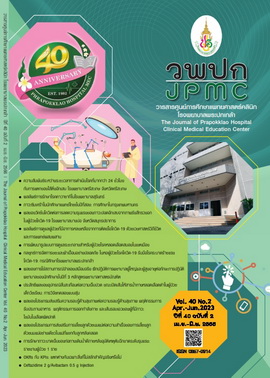The Effects of a Health Literacy Promotion Program on Health literacy, Food consumption Behavior, Exercise Behavior and Waist Circumference of People with Dyslipidemia
Main Article Content
Abstract
BACKGROUND: People with dyslipidemia are at an increased risk of non-communicable diseases such as diabetes, hypertension, coronary heart disease and stroke. Health literacy promotion programs may change health literacy, food consumption behavior, exercise behavior, and waist circumference.
OBJECTIVES: To study the effects of a health literacy promotion programs on health literacy, food consumption behavior, exercise behavior, and waist circumference in people with dyslipidemia.
METHODS: This study was quasi-experimental research. The sample group consisted of 62 people with dyslipidemia who attended annual check-ups at the outpatient department in a medical center hospital in eastern region. They were divided into a control group and an experimental group, with 31 people in each group. The control group received usual nursing care while the experimental group received the health literacy development program for 6 weeks. Tools used to collect data included demographic data, a health record form, a health literacy assessment form, and coronary artery disease preventive behavior questionnaires in part of food consumption behavior and exercise behavior. Data was analyzed by descriptive statistics and independent t-tests.
RESULTS: The results showed that the mean scores for the experimental group consisting of health literacy, food consumption behavior, and exercise behavior at the 12th week of the experiment were statistically higher than before the experiment and higher than the control group (p<0.05). The mean scores of waist circumference at the 12th week were not significantly different between the experimental and control groups.
CONCLUSIONS: This research shows that the program can help people with dyslipidemia improve health literacy, food consumption behavior, and exercise behavior. Nurses and health workers can apply this program for people with dyslipidemia.
Thaiclinicaltrials.org number, TCTR20230213004
Article Details

This work is licensed under a Creative Commons Attribution-NonCommercial-NoDerivatives 4.0 International License.
References
NCD Risk Factor Collaboration (NCD-RisC). Repositioning of the global epicentre of non-optimal cholesterol. Nature2020;582(7810):73-7.
Pirillo A, Casula M, Olmastroni E, Norata GD, Catapano AL. Global epidemiology of dyslipidaemias. Nat Rev Cardiol 2021;18:689-700.
Silaruks S, Sriratanasathavorn C, Rawdaree P, Kunjara-Na-Ayudhaya R, Thinkhamrop B, Sritara P. Prevalence of dyslipidemia and goal attainment with lipid-lowering therapy: insights from Thai multicenter study and overview of the major guidelines. In: McFarlane SI. Dyslipidemia. London: IntechOpen; 2019. p.71-84.
Ekpalakorn W, PuckcharernH, Satheannoppakao W. Thai National Health Examination Survey 6th 2019-2020[Internet]. 2022[cited 2023 Feb 8]; Available from: https://www.hsri.or.th/media/printed-matter/detail/13443
Qi L, Ding X, Tang W, Li Q, Mao D, Wang Y. Prevalence and risk factors associated with dyslipidemia in Chongqing, China. Int J Environ Res Public Health [Internet]. 2015 [cited 2023 Feb 8];12(10):13455-65. Available from: https://www.ncbi.nlm.nih.gov/pmc/articles/PMC4627042/pdf/ijerph-12-13455.pdf
DePhillipsC, Parikh PB, StevensGA. Dyslipidemia: current therapies and strategies to overcome barriers for use. J Nurse Pract 2021;17:1167-73.
Nutbeam D. Health literacy as a public health goal: a challenge for contemporary health education and communication strategies into the 21st century. Health Promotion International 2000;15:259-67.
Nutbeam D. The evolving concept of health literacy. SocSci Med 2008;67:2072-8.
Arahung R, Hoontrakul S, Roojanavech S. The effects of health literacy enhancement program on hypertensive prevention behavior of pre-hypertension risk group at a community in Nakhon Pathom province. Royal Thai Navy Medical Journal 2018;45:509-26.
Thepin K, Moolsart S, Jantacumma N. Effectiveness of a health literacy developmental program in patientswith uncontrolled hypertension. Boromarajonani College of Nursing, Uttaradit Journal 2019;11(1):197-212.
Pannark P, Moolsart S, Kaewprom C. The effectiveness of a program for health literacy development of the patients with uncontrolled type 2 diabetes at Bangwua district, Chachoengsao province. Nursing Journal of the Minitry of Public Health 2017;27(3):91-106.
Sutthipatthanangkoon C, Thato R. Factors predicting preventive behaviors for coronary artery disease among autonomous university staff in Bangkok. Thai Journal of Cardio-Thoracic Nursing 2017;28(2):111-25.
Vasuthada C, Jaikla N, Prakongsri C, Theamngoen S. The development of a self-management support model for non communicable disease prevention among people at risk of chronic illness: Bangkaja, muang district, Chanthaburi province. J Prapokklao Hosp Clin Med Eduact Center. 2019;36:142-53.
Rothberg AE, McEwen LN, Kraftson AT, Ajluni N, Fowler CE, Nay CK, Miller NM et al. Impact of weight loss on waist circumference and the components of the metabolic syndrome. BMJ Open Diabetes Res Care [Internet]. 2017 [cited 2023 Feb 8];5(1):e000341. Available from: https://www.ncbi.nlm.nih.gov/pmc/articles/PMC5337678/pdf/bmjdrc-2016-000341.pdf
